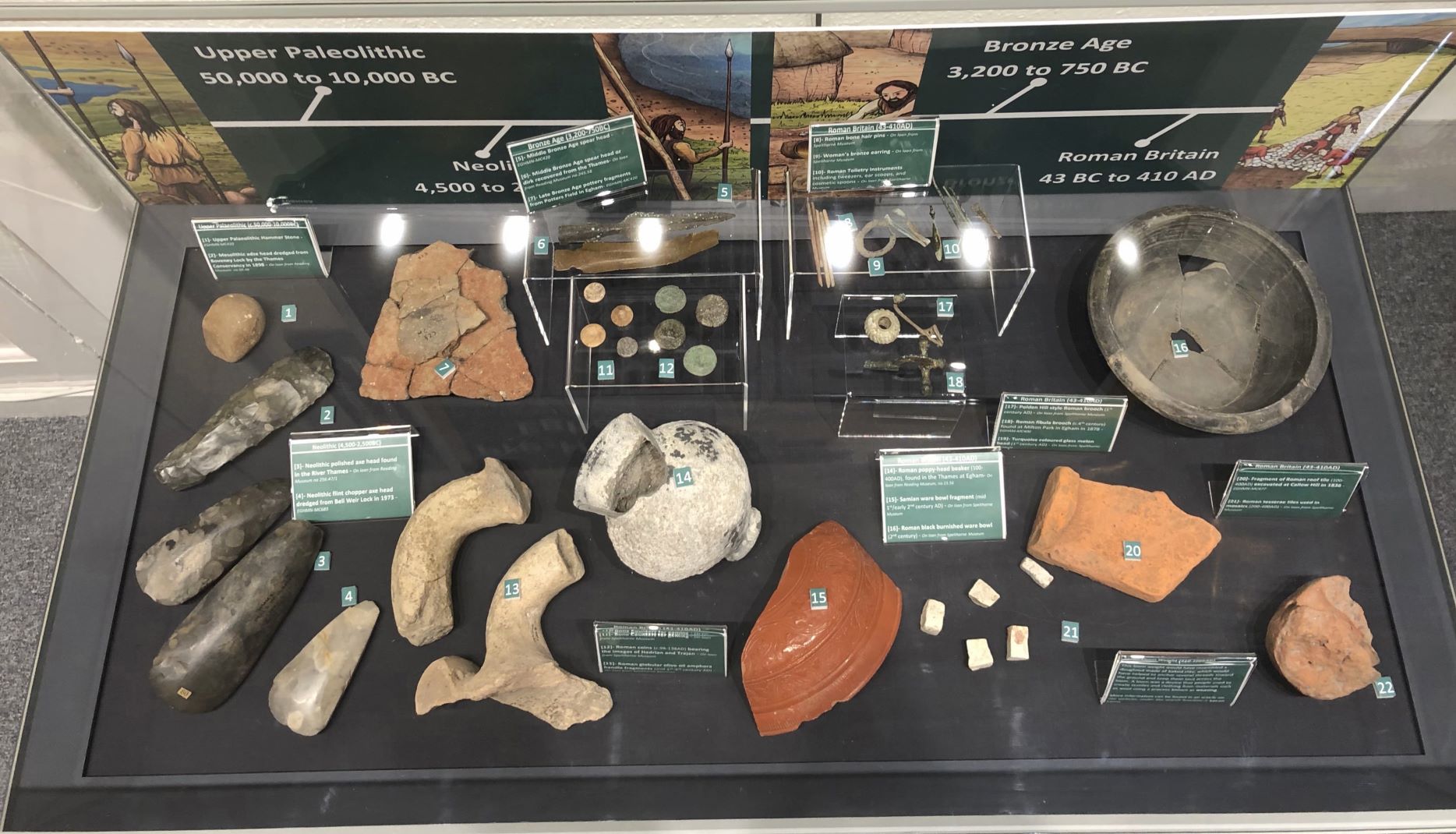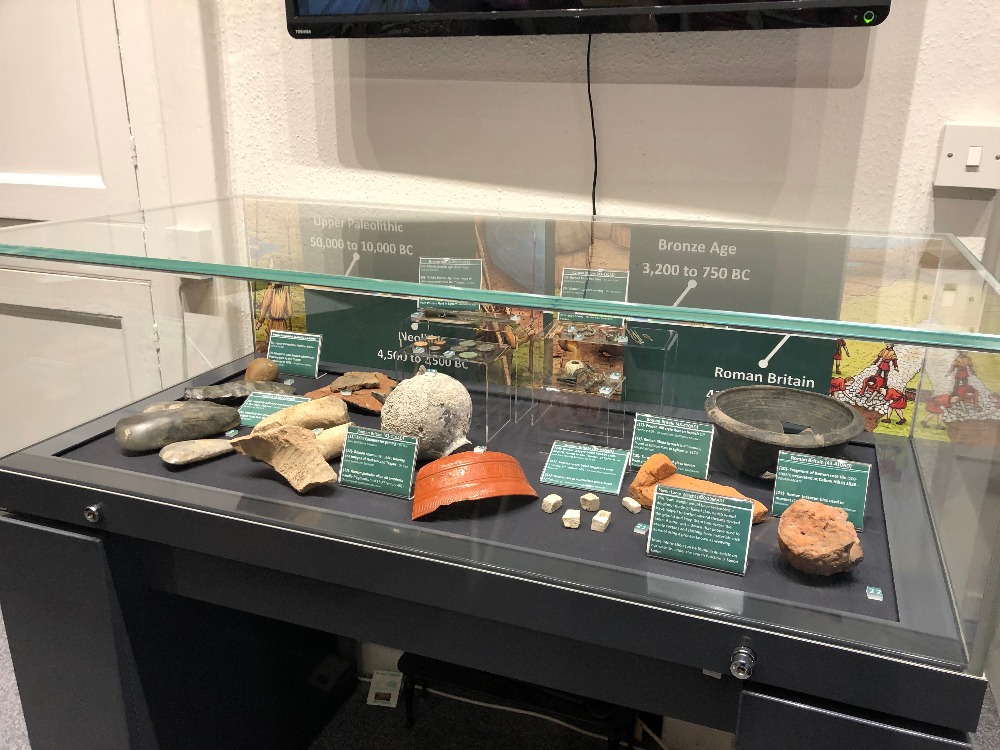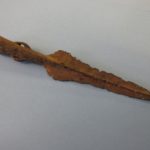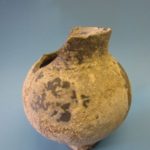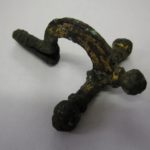Behind the glass: Pre-Historic Egham
The Egham Museum tells the story of Egham, Egham Hythe, Englefield Green, Thorpe and Virginia Water from pre-history to the present day.
We’ve divided these stories into six sections.
Pre-Historic Egham
Medieval Egham
Early Modern Egham
Victorian Egham
Egham at War
Post-War Egham
Our Behind the Glass series gives you a tour of the items in the cases, you can see them all together in our Museum Tour video below.
Pre-Historic Egham
Pre-History: Before 43 AD
People first lived on the site of Egham over 12,000 years ago towards the end of the Stone Age. These people were roaming hunter-gatherers, using simple flint tools to hunt animals for food and clothing. They lived in simple shelters in camps along the riverside.
Gradually people learnt new skills such as how to grow crops and herd cattle and to settled into community life. Soon they discovered how to make bronze and how to craft it into items such as tools, bowls and beakers, as well as ceremonial jewellery. You can find out more about what life would have been like in the Bronze Age on our YouTube channel.
Farming increased with the improvements in in metalwork. Tribes settles and the populations grew. Hill forts have been discovered around many iron age settlements. Hill forts could be a status symbol, a meeting place, define territory or somewhere to trade. They could be a sacred space and sometimes a refuge.
Zoom in on the photo at the bottom of this page to see the items inside the case.
Upper Palaeolithic (c. 50,000-10,000BC)
[1] Upper Palaeolithic Hammer Stone MC420
[2] Mesolithic adze head dredged from Boveney Lock by the Thames Conservancy in 1898 (on loan from Reading Museum no 59.48)
Neolithic (4,500-2,500 BC)
[3] Neolithic polished axe head (on loan from Reading Museum no 256.47/1)
[4] Neolithic flint chopper axe head dredged from Bell Weir Lock in 1973 MC683
Bronze Age (3,200-750BC)
[5] Middle bronze age spear head MC420
[6] Middle Bronze Age spear head or dirk recovered from the Thames (on loan from Reading Museum no 245.58)
[7] Late Bronze Age pottery fragments from Potters Field in Egham (MC420)
Roman and Saxon Egham
Roman and Saxon: 43 AD to 1066 AD
With the arrival of the Romans in 43 AD came the first permanent bridge across the river at Egham Hythe. Although many existing local communities continued with their everyday lives, this connection to the wider Roman empire brought with it new ideas, customs, food and fashion.
It wasn’t until the collapse of the Roman empire in 410 AD that a new wave of settlers migrated to the area: the Saxons. While often portrayed as raiders, the Saxons were just as likely to be farmers and traders.
Saxon heritage can be seen all around us in place names such as ‘Staines’ and ‘Englefield Green’. They also established Egham, which meant “Ecca’s Ham” or “land in the bend of the river”.
Roman Britain (43-410AD)
[8] Roman bone hair pins (on loan from Spelthorne Museum)
[9] Woman’s bronze earring (on loan from Spelthorne Museum)
[10] Roman toiletry instruments including tweezers, ear scoops, and cosmetic spoons (on loan from Spelthorne Museum)
[11] Bone Counters for Gaming (on loan from Spelthorne Museum)
[12] Roman coins (c98 – 138 AD) bearing the images of Hadrian and Trajan (on loan from Spelthorne Museum)
[13] Roman globular olive oil amphora handle fragment (mid 1st – 3rd century AD) ( on loan from Spelthorne Museum)
[14] Roman poppy-head beaker (100-400AD), found in the Thames at Egham ( on loan from Reading Museum)
[15] Samian ware bowl fragment (mid-1st/early 2nd century AD) (on loan from Spelthorne Museum)
[16] Roman black burnished ware bowl (2nd century) (on loan from Spelthorne Museum)
[17] Polden Hill style Roman brooch (1st century AD) (on loan from Spelthorne Museum)
[18] MC400 – Roman fibula brooch with pin (bronze), late 4th century. Found at Milton Park, near The Lodge, formally Little Fosters, by Baron George de Worms in 1878. Donated to the Museum in 1980 by Miss Violet de Worms (Baron de Worms’ granddaughter). Fibulae were used to gather a cloak or strap over the shoulder by means of a pin and socket, and were made from a variety of materials.
[19] Turquoise coloured glass melon bead (1st century AD) (on loan from Spelthorne Museum)
[20] Fragment of Roman roof tile (100-400AD) excavated at Callow Hill in 1836 (MC 477)
[21] Roman tessarae tiles used in mosaics (200-400AD) (on loan from Spelthorne Museum)
Saxon Loom Weight (410-1066AD)
This loom weight would have resembled a doughnut made of baked clay, which would have helped to anchor several threads towards the ground and keep them taut across the loom. A loom as a device that people used to create textiles and clothing from materials such as wool using a process known as weaving. Find out more here.
So that is our Pre-History case, what would you like to see in more detail or find out more about?

